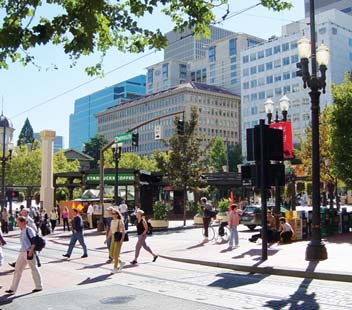“Everyone wanted it to have an ‘urban’ type feel,” said one focus group participant to the State Journal-Register about the new supermarket that Niemann Foods Inc. plans to build at Second and Carpenter, “although it’s in a neighborhood.”
The County Market’s potential shoppers were talking about Starbucks and a deli counter. A surer way to have a supermarket with an urban-type feel is to build an urban-type supermarket. The intersection of Second and Carpenter is smack in the heart of the city, officially part of Springfield’s “central area” as presently construed by planners. Unfortunately, decades of speculative land-banking by Memorial Hospital has replaced people with cars. That particular intersection looks like a country crossroads after the corn’s been taken in. Three of the four corners are parking lots, if you count the CVS across Carpenter from the County Market site, which is a parking lot with an accessory drugstore. CEO Rich Niemann Jr., put his finger on the problem when he referred to “kind of the metro nature of the area.”
Yup, nothing says “urban” as eloquently as a strip mall.
As the AIA Sustainable Design Assessment Team 2012 reported, creating a mix of livable, residential spaces in that part of town shouldn’t be hard, given that about 10,000 potential residents work in the medical district. The reason that mix isn’t being created is that “there is a lack of amenities that would attract those seeking a walkable, urban lifestyle [but] neighborhood retail and service businesses are unwilling to commit without a minimum threshold of residential foot traffic.”
One solution to this familiar chicken-or-egg problem is to provide both chickens and eggs by providing for both amenities and residents at the same time – and what better to do that than a grocery store? A few years ago, Safeway, the big West Coast chain, wanted to replace its aging store in a seen-better-days neighborhood on the fringe of Portland, Oregon’s downtown. The old 29,000-square-foot store was replaced by a 46,000-square-footer that had a very urban-type feel indeed. The new store did not cower behind parked cars like a king on a chess board behind his pawns, but was built right out to the street. Atop the store were 128 mixed-income rental lofts and 12 rental townhouses; below it was a two-level underground parking garage for 220 vehicles – half for shoppers and half for residents.
Given the choice, Safeway builds the same standard-issue suburban store regardless of where it is. It did not build a cookie-cutter store at this particular site in Portland because it wasn’t allowed to. The complex was part of a larger neighborhood revitalization pushed by the Portland Development Commission, the city’s economic development and urban renewal agency which also administers the city’s TIF programs. As such, the PDC does not merely approve private developments, it sets the parameters within which developers may work as a condition of their getting TIF money. The object is to shape projects so they add to their neighborhoods and not only to the city’s tax roll, and in this case that meant no suburban-style market in greater downtown Portland.
Springfield’s Mid-Illinois Medical District has a pretty good development plan for new mixed-use buildings in Springfield’s hospital zone. (It was developed in 2004 by the well-known Baltimore firm, RTKL Associates Inc.) Alas, the MIMD has no money with which to tempt developers into building it. The City of Springfield has money but no plan. That leaves developers free to do the planning for the people of Springfield, even when (as is the case with the $2 million in TIF subsidies that this project enjoys) they are using local tax money.
I am not arguing that the Niemann people risk their money trying to turn Springfield into a lesser Portland – the market will not support anything near as big as the Safeway project – only that in return for local government agencies picking up the tab for a fifth of their project cost they try to make Springfield a better Springfield by building its new market on the street, with flats above. The city could do a lot more to help than merely clearing the site. It is an axiom of the public investment that creating facilities to meet future demand – in this case for housing – help create that demand.
Leverage the Niemann project and give that intersection the concentrated public investment the area needs. Reforest the boulevards. Solicit proposals from developers willing to build a two-story pavilion on the sidewalk elsewhere on that corner, also with flats above and a dry cleaner and maybe a taco shop on the ground floor. And acquire right-of-way now, while so much land remains underused and under-priced, for the leafy bikeways that ought to link this spot with the hospitals and with downtown. That way Springfield will begin to build a real urban neighborhood, not merely a neighborhood that feels like one.
Contact James Krohe Jr. at [email protected].



